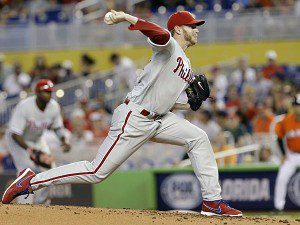
Alright. Let’s talk about Roy Halladay.
- 200 wins
- two-time Cy Young winner
- eight-time All-Star
- perfect game in 2010
- postseason no-hitter (second all-time), also in 2010
- active leader with 66 complete games
- 20 shutouts
- 2,080 strikeouts
That list of accomplishments is absolutely stellar. I don’t think it’s really going out on a limb to say that it’s Hall of Fame good, and his career isn’t over yet.
But it’s more than just numbers that make Halladay great.
He was first nicknamed “Doc” by the late Toronto Blue Jays announcer Tom Cheek, after famous Old West legend Doc Holliday, who was famous for the 1881 gunfight at the O.K. Corral. And it’s fitting, really. They’re both dangerous gunslingers in their own way. And on the 14th day of April in 2013, Halladay (the pitcher, not the cowboy) stepped on the mound for the 406th time, and walked off with his 200th win.
The Toronto Blue Jays and Philadelphia Phillies have both had Roy Halladay grace their rotation, and with that comes more than just a pitcher. Halladay is a completely calming presence on the mound, an intense but focused leader. His stuff is solid and reliable with little-to-no waver, just like him.
But the way his career began, Roy Halladay certainly didn’t look like a sure thing. In fact, he had the textbook look of a flash in the pan.
On a warm Toronto afternoon on September 27, 1998, Roy Halladay made his second career start against the Detroit Tigers. A couple of hours later, he found himself one out away from throwing a no-hitter. Bobby Higginson would step up to the plate and hit a pinch-hit solo home run to end Halladay’s bid. He would retire the next hitter and pick up the first win of his career.
But after that awe-inspiring start, Roy Halladay wouldn’t come into his own for another few years. Over the next few seasons, he would constantly waver between ineffective and average for the Blue Jays. He would record 17 wins and 17 losses from 1999-2001, with a strikingly abysmal ERA of 10.64 in the 2000 campaign.
But then came 2002.
Roy Halladay’s campaign for the Blue Jays is the definition of a breakout year. Earning 19 wins with an ERA under 3.00, he became the Blue Jays’ undisputed ace. Right now, calling Halladay an ace seems natural. In 2002, it was a complete surprise. After three long years of inconsistency, Roy Halladay became the premier pitcher he would remain for the next 10 years.
His two-seam fastball and cutter combination began to baffle batters. Not including two injury-plagued seasons in 2004-05, Halladay would post at least 16 wins for a consistently lackluster Blue Jays squad every year up to 2009, including a career-high 22 wins in 2003 (the year he won his first of two Cy Young awards). He quickly became one of Toronto’s most beloved athletes in what was a very poor decade for baseball in the city.
And of course, he had his accolades. He appeared in All-Star games, won the Cy Young, and consistently led the American League in a number of categories.
But he never accomplished something that haunts so many all-time greats. He never won the big one.
The Blue Jays were re-building and Roy Halladay wasn’t getting any younger. So, in a trade that saw many talented prospects head north to Toronto, Doc threw on a Phillies uniform for the 2010 season. And Philadelphia got to see why Toronto loved him so much.
In his first season in a Phillies uniform, Halladay won 21 games, threw a perfect game and threw a postseason no-hitter. He proved he could pitch on a grand stage, and that he was determined to get that World Series title. Even though they lost in the NLCS, Philadelphia fans latched onto Doc, and he became a fan favorite in a new city.
But Toronto hadn’t forgotten him. When he returned to the Rogers Centre in July of 2011, he received a standing ovation. He pitched there when it was called the SkyDome, he was the best Blue Jays player of the decade, and the fans hadn’t forgotten that.
Roy Halladay has seen his share of troubles as of late. His age may finally be showing a little bit on the mound. He’ll be turning 36 in a month. The velocity that was a big part of Cheek’s nickname for him is seemingly gone with injuries. And this season has undoubtedly started poorly for him, especially after a less-than-stellar showing last season.
Amidst the whispers of his imminent downfall, Roy Halladay remains focused. Immediately after his 200th victory, he said all that matters is winning that World Series championship.
After all, Roy Halladay was once just a kid, watching Nolan Ryan chalk up a legendary career. He hoped to emulate him one day.
Now, kids the world over are watching Roy Halladay, hoping one day they can be just like Doc.
